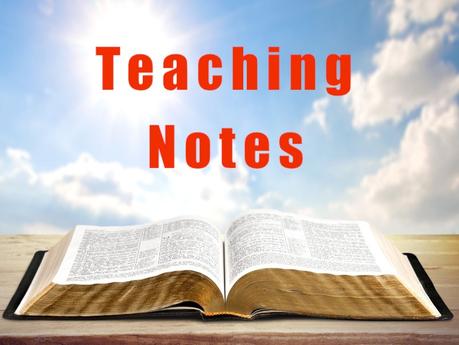Grace Thoughts
Teaching Notes: On Matthew’s Gospel (Part 4)

Teaching Notes are Bible studies we taught before GraceLife Ministries began publishing articles online in 1995. Some were presented as sermons, others as group studies.
Our hope is that these older studies will be a blessing to you in your life and ministry. Please use them in any way God leads you.
These teaching notes are from a series of studies about the Gospel of Matthew.
[These notes are from a study prepared 45 years ago.]
Outline of Matthew 12
I. Jesus deals with the Pharisees on the matter of the Sabbath. 1-23
A. The Pharisees accuse His disciples of breaking the Law in picking the grain for food. 1-2
B. Christ uses an example from the Old Testament to answer them. 3-5
C. Christ demanded heartfelt mercy of them and not ritualistic sacrifice. 6-8
D. The Pharisees try to accuse Him again as He heals a paralyzed man on the Sabbath. 9-10
E. Christ likens His healing to that of a Shepherd concerned about an endangered sheep. 11-13
F. The Pharisees hold a meeting to plot for His life. 14
G. Christ continues to heal on the Sabbath and in so doing fulfilled Old Testament prophecies. 15-21
H. The people are amazed and wonder at His power. 22-23
II. Jesus deals with the Pharisees on the matter of His source of power. 24-32
A. The Pharisees claim that Christ’s power comes from Satan. 24
B. Christ rebukes their thinking. 25-30
C. Christ warns them of a sin which has no pardon or forgiveness. 31-32
III. Jesus deals with the Pharisees on the matter of their evil fruit. 33-37
A. Christ knew who they were and the condition of their hearts by their corrupt speech. 33-35
B. Christ tells them of their judgment. 36-37
IV. Jesus deals with the Pharisees on the matter of signs. 38-42
A. The Pharisees ask Christ for a sign. 38
B. Christ points to the signs already given by Jonah and the Queen of Sheba. 39-42
V. Jesus deals with the Pharisees on the matter of self-reformation and God-regeneration. 43-50
A. Christ shows the worthlessness of self-reformation and religious hypocrisy. 43-45
B. Christ explains the new relationship when a person has placed his trust in Him. 46-50
Objective Summary of Commentary Material on Matthew 12
This chapter focuses on the complete rejection of the Kingdom. It is a great turning point in Matthew’s Gospel. The Kingdom messengers were rejected by the Pharisees. 1-8
Christ declared Himself Lord of the Sabbath and healed a man’s hand on the Sabbath. 9-14
Christ then intimated a turning to the gentiles. This would await final rejection at Calvary and His rejection after the resurrection. 15-21
The healing of the demoniac led to the blasphemy of the Pharisees. 22-24
They committed the unpardonable sin of attributing the works of Christ to Satan’s power. Christ pronounced judgment once again and prophesied of Israel under a demonic figure. 25-45
Unger’s Bible Handbook, p 477
Matthew here shows the nature of Pharisaic hostility. The disciples of Christ plucked grain which was legal. The Rabbinical teachings called plucking reaping, but it wasn’t. Jesus used an Old Testament passage to remind the Pharisees that extreme human need overrules certain regulations. Also, the priests were required by Law to work on the Sabbath furthering temple worship. How much more the disciples were guiltless in working for Christ, the reality to which the Temple pointed. 1-6
On another Sabbath (Luke 6:6-11) the Pharisees tied to cause Christ of working on the Sabbath by healing. The O.T. makes no prohibition, but some rabbis taught that it was work. Christ was obligated to help a lamb and more so a man in need. 9-13
This miracle enraged the Pharisees to plot His death. 14
Christ went to other areas to deal with the needs of men. His gracious, non-provocative ministry was fulfillment of Messianic prophecy. 15-21
Though Christ’s power to cast out demons raised the possibility of His Messiahship, the people were predisposed to unbelief. 22-23
Christ answered the vicious charges of the Pharisees in an effective way. He used a simple analogy and the claim by Pharisees of having exorcism power to refute the charge made against Him. 24-29
Though Christ could forgive every sin and blasphemy, there was one sin that had no pardon — speaking against the Holy Spirit. 31-32
The speech of men is indicative of the state of the human heart. 33-35
On the judgment day Christ will consider every man’s life in it entirety. 36-37
The Pharisees apparently discounted previous miracles and asked for a sign. They wanted some sensational deed in keeping with their ideas of the Messiah. 38
Israel was spiritually unfaithful to Jehovah. 39
Christ gave them Jonah as the sign. His resurrection is foretold. 40
Ninevah was a judgment to Israel for they repented at Jonah’s preaching, but Israel had failed to repent to Christ, one greater than Jonah. 41
The Queen of Sheba was also a judgment to Israel, since she, a gentile, was greatly interested in Solomon’s wisdom and Israel had no interest in the Wisdom of God, Jesus Christ. 42
Verses 43-45 is a parable speaking of a greater degeneration of Israel. Christ teaches that the spiritual relationship between Himself and believes was closer than blood ties. All who did the will of God, “that ye believe on Him whom He hath sent” (John 6:29) would have the blessed fellowship of Christ forever. 46-50
Wycliffe’s New Testament Commentary
The theme of this chapter is the conflict and final break of Jesus with the Religious rulers. The final break came over the sabbath. This matter so enraged the Pharisees that they plotted the death of Christ and did not finish until He hung on the cross.
J. Vernon McGee’s Commentary on Matthew 12
Personal Interpretation of Matthew 12
Jesus and His disciples broke no laws when they plucked grain from the fields. They were not reaping a harvest, they were simply feeding their hunger. The Pharisees had added man’s teaching to the Word of God and were wrong in their accusations. 1-2
Jesus used an historical account from the days when David was being rejected by Saul. Just as the rejected King David fed his hunger, so the rejected King Jesus and His disciples ate. 3-4
Jesus claimed to be greater than the holy temple, which He was. He also claimed to be Lord of the Sabbath, which was the same as claiming to be God. 5-8
The Pharisees were not through with Christ. They asked Him if He thought it lawful to heal on the Sabbath. Christ asked them if saving the life of a sheep was lawful. Of course it was and saving a man is far more important. 9-13
The Pharisees went out to plan Christ’s death, but since His time had not come, He departed from them. 14-16
Jesus was a constant fulfillment of Old Testament Scripture. 17-21
The Pharisees, still plotting His death, were faced with the fact that Christ could perform miracles. They finally came up with a plan — claim that Jesus was of the devil. 21-24
However, Jesus was far too smart to be hurt by them. He simply put their comments away with the truth about Satan’s kingdom and the Kingdom of God. Those who would believe the lies of the Pharisees were enemies of Christ. 25-30
This particular accusation that the work of the Holy Ghost was the work of Satan was an unpardonable sin. 31-32
The Pharisees could only speak hatefully and bitter fully because of their heart condition. All men will one day answer for their heart motives. 33-37
The Pharisees asked for a sign of Jesus’ credentials as the Messiah. Jesus saw their evil unbelief and gave them the sign of Jonah who was swallowed by a great fish for three days and nights. This spoke of His future crucifixion, burial and resurrection. The men of Ninevah had more spiritual insights than the Pharisees because they repented at the preaching of Jonah. The Pharisees refused the preaching of Christ. 38-41
Another sign given was the gentile Queen of Sheba who traveled far and long to hear the wisdom of Solomon. Christ was far wiser than Solomon and the Pharisees had Him nearby, but they were stupid and foolish and couldn’t see God at work in their midst. 42
The Pharisees were outwardly strict and pretended to be righteous. But their hearts were wicked and their final state would be worse than before. 43-45
The relationship that a truly saved person has with Christ is closer than any earthly relationship. 46-50
Practical Usage of Matthew Chapter 12
Personal Development:
Verses 1-13 are a reminder to always seek the spirit of the law. I don’t ever want to become legalistic about worship or religion. Christ sets the example of one who sees far beyond the letter and into the deeper spirit of any situation. Oh, that I might be more like Christ!
Next Time
We will look at the outline for Matthew Chapter 13 in the next part of our special series.
[Thank you for reading these teaching notes from 45 years ago. My prayer is they will be a blessing to you and your ministry.]


Published by gracelifethoughts
Founder & Director of GraceLife Ministries View all posts by gracelifethoughts
